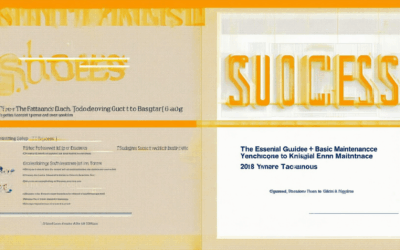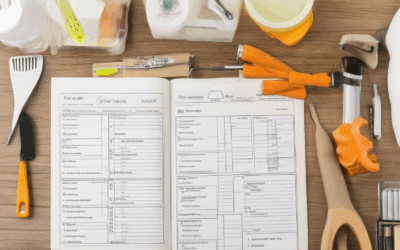Apartment living comes with its unique set of challenges, especially when it comes to maintaining your space. From minor repairs to major fixes, staying on top of monthly maintenance tasks can feel overwhelming at times. Whether you’re new to renting or have been a tenant for years, keeping track of repairs and upkeep is crucial for ensuring your home stays in great shape. This guide will walk you through proven monthly repair tips tailored specifically for tenants, helping you navigate the complexities of apartment maintenance with ease and confidence. By understanding the basics of home maintenance, budgeting wisely, and adopting organized routines, you can address issues before they escalate and enjoy a comfortable living environment year-round. Let’s dive into how you can master apartment maintenance and maintain your peace of mind.
Key Takeaways
– Create a maintenance budget to cover unexpected repair costs and planned upgrades.
– Develop a weekly cleaning schedule to keep your space tidy and prevent buildup.
– Regularly inspect major appliances like HVAC systems and refrigerators for optimal performance.
– Check electrical systems and plumbing for leaks or issues to prevent costly damage.
– Tackle seasonal tasks such as gutter cleaning, roof inspections, and preparing for winter.
– Secure outdoor items and inspect roofs during summer and winter months.
– Schedule long-term maintenance for landscaping, deck inspections, and foundation checks.
– Invest in tools and hire professionals to streamline tasks and ensure quality work.
– Stay organized with a shared calendar and subscribe to local alerts for maintenance concerns.
– Consider low-maintenance features like durable materials and energy-efficient appliances.

The 1% Rule for Home Maintenance
The 1% rule for home maintenance is a helpful guideline for homeowners to budget and manage routine upkeep. This rule suggests allocating 1% of your home’s assessed value annually for maintenance tasks. For instance, if your home is valued at $200,000, you would aim to set aside $2,000 each year for maintenance projects.
Steps to Implement the 1% Rule
- Assess Your Home’s Value : Determine your home’s current market value through an appraisal or online tools.
- Calculate Your Annual Budget : Multiply the assessed value by 1% to get your yearly maintenance budget.
- Prioritize Repairs and Upkeep : Use your budget for essential tasks like fixing leaks, updating fixtures, and seasonal preparations.
Why the 1% Rule Works
- Predictable Expenditures : Helps you prepare financially for unexpected repair costs.
- Long-Term Savings : Prevents minor issues from escalating into major, costly repairs.
- Peace of Mind : Ensures your home remains in good condition, preserving its value over time.
Practical Tips for Applying the Rule
- Create a Maintenance Schedule : Regularly inspect your home for potential issues.
- Budget for Small Projects : Allocate part of your budget for quick fixes and small improvements.
- Consider Professional Help : For tasks outside your skill level, hire trusted professionals.
Resources for Homeowners
For more guidance on implementing the 1% rule and learning about home maintenance best practices, visit Sams Maintenance . Our team provides detailed resources and expert advice to help you keep your home in excellent shape.
How Much Should You Save Each Month for Home Repairs?
To determine how much you should save each month for home repairs, consider the following factors:
- Home Value : A common recommendation is to save 1% of your home’s purchase price each month. For example, if your home is valued at $300,000, you would aim to save $3,000 per month. However, this can be adjusted based on your comfort level and financial situation.
- Home Age and Condition : Older homes may require more frequent repairs, potentially increasing the amount you should save. Conversely, newer homes may need less due to better construction and warranties.
- Frequency of Repairs : Consider the likelihood of repairs in your area. Homes in areas prone to severe weather may benefit from a slightly higher savings rate.
- Emergency Fund : Experts advise setting aside at least $2,000 for unexpected repairs, such as a broken water heater or major appliance failure.
- Insurance Coverage : Review your homeowners insurance policy to understand what is covered and what isn’t, as this will affect your savings strategy.
- Allocation of Funds : Decide how to allocate your savings, such as dedicating portions to appliances, plumbing, and HVAC systems.
- Ongoing Maintenance : Include funds for regular maintenance and inspections to prevent minor issues from becoming major problems.
- Review and Adjust : Periodically reassess your savings plan to ensure it meets your needs and adjust as necessary.
By considering these factors, you can create a savings strategy tailored to your home’s needs and financial capabilities.

What is the Average Monthly Maintenance?
The average monthly maintenance cost for a home varies widely depending on its size, location, and condition. However, there are several key components that contribute to monthly maintenance costs:
- Utilities: This includes electricity, water, heating, cooling, and garbage disposal. On average, utilities can range from $200 to $400 per month.
- Property Taxes: Property taxes vary by location but typically range from $50 to $300 per month.
- Home Insurance: Homeowners insurance is essential and usually falls between $50 and $200 per month, depending on the coverage level and local factors.
- Maintenance Costs: This covers minor repairs, replacements, and routine upkeep. On average, this can range from $100 to $300 per month.
- Other Expenses: Factors like landscaping, fence repair, or HOA fees can add an additional $50 to $150 per month.
The total average monthly maintenance cost for a home is typically between $500 and $1,000 per month, depending on the factors mentioned above. Regularly reviewing and addressing maintenance needs can help keep these costs manageable and prevent unexpected expenses in the future.
To reduce maintenance costs, consider implementing preventive maintenance practices recommended by professionals. These practices can extend the life of your home and reduce the frequency of costly repairs.

How to Keep Up with House Maintenance
To maintain a healthy home environment, staying proactive with routine tasks is essential. Below are organized tips to help you manage house maintenance effectively:
- Monthly Checklists
- Budgeting:** Create a monthly maintenance budget to cover unexpected repairs and planned upgrades.
- Cleaning:** Develop a weekly cleaning schedule to tackle specific areas, such as bathrooms, kitchens, and bedrooms.
- Appliance Checks:** Regularly inspect major appliances like HVAC systems, refrigerators, and dishwashers for optimal performance.
- Electrical Systems:** Test circuit breakers and ensure all electrical outlets are functioning properly.
- Plumbing:** Check for leaks under sinks and around pipes to prevent costly damage.
- Seasonal Tasks
- Spring Cleaning:** Tackle tasks like clearing gutters, pruning trees, and pressure washing exterior surfaces.
- Summer Preparation:** Inspect roofing for missing shingles and prepare for storm season by securing outdoor furniture.
- Winter Readiness:** Clear snow from gutters and check for ice dams to prevent water damage.
- Long-Term Maintenance
- Landscaping:** Schedule regular lawn mowing, weed control, and tree trimming services.
- Deck and Fence Inspection:** Replace rotten wood and tighten loose screws to maintain structural integrity.
- Exterior Painting:** Refresh your home’s appearance with a fresh coat of paint every few years.
- Foundation Checks:** Look for cracks or unevenness in your home’s foundation that could indicate structural issues.
- Actionable Steps
- Create a shared calendar for family members to track maintenance tasks.
- Invest in tools and equipment that simplify repetitive tasks, such as a cordless drill or a pressure washer.
- Consider hiring professionals for specialized tasks, like gutter installation or chimney cleaning.
- Stay informed by subscribing to local weather alerts and neighborhood watch groups for potential maintenance concerns.
By organizing these tasks and staying consistent, you can ensure your home remains in great shape year-round. For additional resources and expert advice, visit our house maintenance guide .
What Makes a House Low Maintenance?
A house can be considered low maintenance if it combines practicality with durability, minimizing the need for frequent repairs and upkeep. Here are the key factors that contribute to a low-maintenance home:
- Location :
- Being situated in an area with good infrastructure, such as proximity to grocery stores, schools, and healthcare facilities, simplifies daily routines.
- Access to reliable public services like trash collection and utilities further reduces maintenance concerns.
- Building Materials :
- Using materials like vinyl siding and aluminum windows reduces the need for frequent painting and ensures durability.
- Energy-efficient features, such as double-pane windows and insulated doors, enhance comfort while lowering utility bills.
- Appliances :
- Modern, energy-efficient appliances often come with longer warranties and require less maintenance.
- Smart appliances allow remote control, adding convenience and reducing the need for manual adjustments.
- Landscaping :
- Features like rock gardens, permeable paving, and native plants minimize maintenance requirements.
- Well-chosen trees and shrubs that thrive in the local climate reduce the need for constant yard work.
- Roofing :
- Tile or metal roofing options are long-lasting and require minimal upkeep.
- Proper insulation prevents moisture damage and enhances energy efficiency.
- Interior Features :
- Easy-to-clean flooring materials, such as hardwood or tile, reduce maintenance.
- High ceilings create a spacious feel and can mask noise, contributing to a peaceful environment.
- Windows and Doors :
- Beyond basic functionality, consider features like solar shades to protect against UV rays and reduce glare.
- Security systems add peace of mind and reduce the risk of break-ins.
- Professional Maintenance :
- Hiring professionals for tasks like plumbing and electrical work ensures issues are addressed before they escalate.
- Future-Proofing :
- Incorporating features like ramps or elevators addresses future accessibility needs.
- Energy-efficient upgrades today can save money and reduce environmental impact in the long term.
By thoughtfully selecting these elements, a house becomes not only a comfortable retreat but also a low-maintenance investment that saves time and money over its lifetime.

How to Keep Up with Housework While Working Full-Time
Balancing housework with a full-time job requires careful planning and organization. Here’s a step-by-step guide to managing both effectively:
- Set Priorities:** Identify essential tasks that must be done daily, weekly, and monthly. Focus on high-priority items first.
- Create a Daily Routine:** Dedicate specific times during your day for chores. Consistency helps maintain momentum.
- Delegate Where Possible:** If feasible, delegate tasks to others or automate repetitive chores like vacuuming or laundry.
- Use Time Management Tools:** Employ apps or planners to track tasks and set reminders for chores.
- Break Tasks Into Smaller Steps:** Divide large tasks into manageable parts to avoid feeling overwhelmed.
- Maintain a Clean Space:** Keep frequently used items accessible to save time and reduce clutter.
- Stay Consistent:** Regularly perform chores, even if only a little each day, to prevent buildup.
- Care for Yourself:** Ensure adequate rest, nutrition, and mental health to sustain energy levels.
- Automate Where Possible:** Utilize technology to handle routine tasks, like setting the washing machine or using a robotic vacuum.
- Celebrate Progress:** Acknowledge completed tasks to stay motivated and recognize achievements.
By implementing these strategies, you can maintain a balanced lifestyle that accommodates both career commitments and household responsibilities.




0 Comments